Jacob Höppli pottery factory
The pottery factory founded by Johann Jacob Höppli owes its rise and early success to the "building boom" in the second half of the 19th century. Façade elements and decorative elements were often made of clay for reasons of cost, but also for reasons of better weather resistance, which promoted the rise of the pottery factory in the middle and second half of the 19th century.
Since the establishment of its own workshop in 1863, the modest three-man operation with Höppli as the leading master craftsman in Dotzheimer Strasse developed into a prosperous medium-sized business within just a few years. The early death of the company founder in 1876 and the general economic downturn of the last quarter of the century almost brought the company to an abrupt end. The eldest son, Christian Höppli (*1864), took over the business in 1892 and the workshops at the new company headquarters in Wörthstrasse, which had only been completed shortly after Jacob Höppli's death. In 1914, the company switched to the production of electroceramic products, but did not survive the inflation and went bankrupt in 1928/29.
Examples of the very high-quality and subtle architectural ceramic products of the Jacob Höppli pottery factory can be found almost everywhere in Wiesbaden - the most striking are the caryatids (figures of girls modeled on the Erechtheion koren in Athens), which can be found at the company headquarters in Wörthstraße, in Rheinstraße 85 and 90, in Viktoriastraße 19 and in Albrechtstraße 35. The first clay products signed by Jacob Höppli are the various decorative elements of the Wiesbaden market church. The crabs and Gothic decorative forms of the spires of St. Boniface 's Church also originate from his workshop. He was also involved in the ornamental decoration of the synagogue on the Michelsberg.
Outside Wiesbaden, the company was involved in the reconstruction of the southern church tower of the so-called Rheingau Cathedral in Geisenheim, the figures on the rotunda of Biebrich Palace were sculpted in Höppli's workshops; the Gothic decorative elements of the Ladenburg, Oberlahnstein and Erbach churches also originate from here.
One of the company's most recent tangible commissions is the five large relief panels depicting the singing contest from the Tannhäuser saga on the so-called Wartburg, at Schwalbacher Straße 51.
Literature
Höppli & Chomicki. Between art and craft, photography and architecture. Exhibition catalog. Texts: Birgit Kita & Thomas Weichel, images: Stanislav Chomicki, Wiesbaden 2008.
Sigrid Russ, editor, Denkmaltopographie Bundesrepublik Deutschland. Cultural monuments in Hesse. Wiesbaden I.1 - Historical pentagon. Ed.: State Office for Monument Preservation Hesse, Stuttgart 2005.
Sigrid Russ, editor, Denkmaltopographie Bundesrepublik Deutschland. Cultural monuments in Hesse. Wiesbaden I.2 - City extensions within the ring road. Ed.: State Office for Monument Preservation Hesse, Stuttgart 2005.
Sigrid Russ, editor, Denkmaltopographie Bundesrepublik Deutschland. Cultural monuments in Hesse. Wiesbaden I.3 - Urban extensions outside the ring road. Ed.: State Office for Monument Preservation Hesse, Stuttgart 2005.
